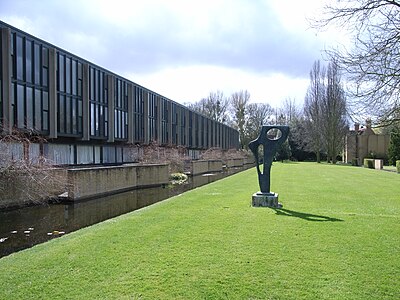Portal:University of Oxford
| Main page | Indices | Projects |
The University of Oxford portal
The University of Oxford is a collegiate research university in Oxford, England. There is evidence of teaching as early as 1096, making it the oldest university in the English-speaking world and the world's second-oldest university in continuous operation. It grew rapidly from 1167, when Henry II banned English students from attending the University of Paris. After disputes between students and Oxford townsfolk in 1209, some academics fled north-east to Cambridge where they established what became the University of Cambridge. The two English ancient universities share many common features and are jointly referred to as Oxbridge.
The University of Oxford is made up of thirty-nine semi-autonomous constituent colleges, four permanent private halls, and a range of academic departments which are organised into four divisions. Each college is a self-governing institution within the university, controlling its own membership and having its own internal structure and activities. All students are members of a college.
It does not have a main campus, but its buildings and facilities are scattered throughout the city centre. Undergraduate teaching at Oxford consists of lectures, small-group tutorials at the colleges and halls, seminars, laboratory work and occasionally further tutorials provided by the central university faculties and departments. Postgraduate teaching is provided in a predominantly centralised fashion.
Oxford operates the Ashmolean Museum, the world's oldest university museum; Oxford University Press, the largest university press in the world; and the largest academic library system nationwide. In the fiscal year ending 31 July 2023, the university had a total consolidated income of £2.92 billion, of which £789 million was from research grants and contracts.
Oxford has educated a wide range of notable alumni, including 30 prime ministers of the United Kingdom and many heads of state and government around the world. 73 Nobel Prize laureates, 4 Fields Medalists, and 6 Turing Award winners have matriculated, worked, or held visiting fellowships at the University of Oxford, while its alumni have won 160 Olympic medals. Oxford is the home of numerous scholarships, including the Rhodes Scholarship, one of the oldest international graduate scholarship programmes. (Full article...)
Selected article
The university's position of Savilian Professor of Astronomy was established in 1619. It was founded (at the same time as the Savilian Professorship of Geometry) by Sir Henry Savile, a mathematician and classical scholar who was Warden of Merton College and Provost of Eton College. He appointed John Bainbridge as the first professor. There have been 21 astronomy professors in all; Steven Balbus, the current professor, was appointed in September 2012. Past professors include Christopher Wren (1661–73) (pictured), architect of St Paul's Cathedral in London and the Sheldonian Theatre in Oxford; he held the professorship at the time of his commission to rebuild the cathedral after it was destroyed by the Great Fire of London in 1666. Three professors have been awarded the Gold Medal of the Royal Astronomical Society: Charles Pritchard (1870–93), Harry Plaskett (1932–60) and Joseph Silk (1999–2012). The two Savilian chairs have been linked with professorial fellowships at New College since the late 19th century. The astronomy professor is a member of the Sub-Department of Astrophysics at Oxford. (Full article...)
Selected biography
Selected college or hall
The Queen's College was founded in 1341 by Robert de Eglesfield, chaplain to Queen Philippa of Hainault (the wife of King Edward III), and is named after her. The main college buildings are in the centre of Oxford, on the High Street, and the front of the college was designed by the 18th-century architect Nicholas Hawksmoor. The college has traditionally had strong links with the north of England: the founder's family had land in the area of Eaglesfield, Cumbria, and until the 20th century a number of scholarships were reserved for men from 20 schools in Yorkshire, Westmorland and Cumberland. The Neda Agha-Soltan Graduate Scholarship, named after an Iranian student who died in the 2009 Iranian election protests, was established at Queen's in 2009. There are about 350 undergraduate and 130 postgraduates. The Provost of the college is the chemistry professor Paul Madden. Former students at the college include the astronomer Edmund Halley, the comedian Rowan Atkinson, the internet pioneer Tim Berners-Lee, the neurologist Oliver Sacks and the theologian John Wycliffe. The Dean Ireland's Professorship of the Exegesis of Holy Scripture is one of the university posts linked to the college. (Full article...)
Selected image

Did you know
Articles from Wikipedia's "Did You Know" archives about the university and people associated with it:
- ... that before Charles Aitken installed electric lighting, the Tate Gallery (pictured) was cleared of visitors on dark and foggy days?
- ... that in 1964 J. N. L. Baker, Bursar of Jesus College, became the first member of the university to hold the post of Lord Mayor of Oxford?
- ... that although George Bernard Shaw called fellow Edwardian playwright St John Hankin's death "a public calamity," his work was largely neglected until the 1990s?
- ... that "many-sided" priest Father Patrick McLaughlin promoted links between the church and the world of literature by staging plays, and by commissioning lectures from T. S. Eliot and Dorothy L. Sayers?
- ... that in 1612 Jewish teacher Jacob Barnet was arrested and imprisoned by officials of the university for changing his mind about being baptized?
Selected quotation
Selected panorama
Wikimedia
The following Wikimedia Foundation sister projects provide more on this subject:
-
Commons
Free media repository -
Wikibooks
Free textbooks and manuals -
Wikidata
Free knowledge base -
Wikinews
Free-content news -
Wikiquote
Collection of quotations -
Wikisource
Free-content library -
Wikiversity
Free learning tools -
Wikivoyage
Free travel guide -
Wiktionary
Dictionary and thesaurus















